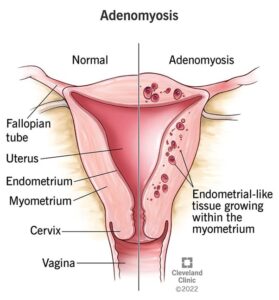Like endometriosis, diagnosing adenomyosis can be a long and emotional process for many women. The symptoms are similar to other gynaecological conditions and the medical testing can be quite invasive, so we often see women living in pain for many years before seeking help or reaching a diagnosis. Not only this, but for many women it is hard to know what a normal period should feel like if they have been dealing with chronic pain since the onset of menstruation. Properly tailored exercise can reduce the impact of your symptoms and improve general mood and wellbeing to support you to do the things you enjoy doing.
WHAT IS ADENOMYOSIS?
Adenomyosis is a chronic health condition affecting approximately 1 in 10 people assigned female at birth. It is common to see adenomyosis co-occur with endometriosis however, there is a distinct difference between the two. Endometriosis is when the lining of the uterine wall is found outside of the uterus, usually within the pelvic region whereas, adenomyosis is when this tissue is found within the wall of the uterine muscle itself. Just like the lining of the uterus, this tissue bleeds during your menstrual period which often results in pain, fatigue and low mood.
Symptoms of Adenomyosis:
- Lower back and/or pelvic pain
- Dyspareunia (painful sex)
- Dysmenorrhea (painful periods)
- Pain during or after bladder/bowel movements
- Fatigue
- Abnormal bleeding
- Infertility
- Low mood, decreased work productivity, anxiety, depression
HOW AND WHY SHOULD I EXERCISE?
It is currently unknown whether exercise has a direct impact on the adenomyotic tissue itself, however we do know that exercise can improve your symptoms and quality of life. Common medical treatments for adenomyosis involve hormonal therapies, pain medication and/or surgery, all of which come with many side effects. Fortunately, these can also be managed by moving your body regularly!
Myofascial Stretching/Release
When faced with chronic pain, many may report they feel ‘tight’ which generally signifies a protective response in the body. Slow and controlled stretches for the pelvis, hips and torso can assist in reducing tension and improving pain. Try gentle yoga or stretches that feel good and can flow together well to minimize needing to change positions too regularly, particularly in the presence of pain. It is also important to ensure you can maintain your usual breathing throughout and gently move in and out of the stretch rather than holding it for greater benefit.
Low-Moderate Intensity Cardiovascular Exercise
Cardiovascular based exercise involves any repetitious movement which increases your heart rate and makes you a little short of breath. To start with, try something gentle that you enjoy like bushwalking, swimming, cycling or dancing. Aim for a moderate intensity, a good indicator of this is when you are able to talk but you cannot sing. This type of exercise has been shown to improve mood, productivity, fatigue and overall health and wellbeing. It also improves blood flow to the uterus which can manage pain and cramping.
Strength Training
Not all strength training needs to be done in the gym. Completing resistance exercises in a slow and controlled manner can promote lengthening which can assist in managing pain. If you’re new to lifting weights, try completing bodyweight exercises first before progressing into machine or free weights. If it doesn’t feel right, contact an Accredited Exercise Physiologist (AEP) to find which resistance exercises will suit you most! If you are currently attending a gym, an AEP may be able to help you modify your current program for when you experiencing more pain to continue to feel the benefits of movement without overdoing it.
Pelvic Floor Downtraining
Pain and tension in the muscles which make up the pelvic floor is common in women with adenomyosis. These muscles help to support our internal organs and play a vital role in bladder, bowel, and sexual function. Specific exercises can be recommended by an AEP to lengthen and elongate these muscles to help improve function and reduce pain. There are also specific tools and techniques that a Pelvic Floor Physiotherapist will be able to prescribe if you are at the beginning of your journey or notice a change in symptoms.
Remember that you might have to try a few different types of exercise before you find what works best so stick at it. If you are unsure where to start or would like help building your confidence with exercise and movement, an Accredited Exercise Physiologist will be able to help!




